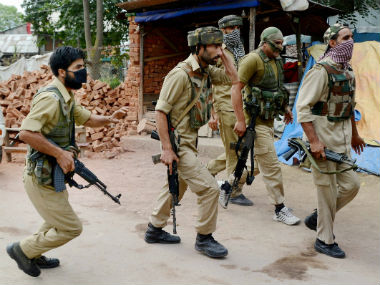It’s now official. On 16 May, the Centre announced a conditional ceasefire in Kashmir during Ramzan. The objective of the ceasefire is also clearly stated as intended to help people observe the holy month in prayers and due solemnity. The announcement, however, also makes it clear that the ceasefire will not apply if security forces are attacked, or if terrorists launch attacks on innocent people. News coverage of crowds apparently protecting terrorists notwithstanding, the killing of innocents is more common than one would think. Terrorists don’t really care very much whom they kill. Their objective is to create a climate of unrest and fear. [caption id=“attachment_4434571” align=“alignleft” width=“380”] Representational image. PTI[/caption] The ceasefire announcement has been greeted variously.
Those with a clear insight into the situation underlined that far from being a sing of weakness, the ceasefire was a display of confidence by the security forces, and a part of the government’s “will to peace”. Others
cited past failures of such initiatives as a reason not to opt for a ceasefire. On the other hand, some others suggested that the ceasefire be accompanied by an
“Operation Comeback” referring to ongoing but intermittent offers by the security forces to persuade young local militants to opt for a surrender and a return to their homes and hearths. All of these are solid points of view, echoing differing experiences and “lessons learnt” in the Valley. The most telling comment, however, came from the chief minister herself. She is
reported to have said, “I hope Pakistan will respond positively to the ceasefire. I hope militants, while respecting the holy month of Ramzan, will respond positively and help in stopping the bloodshed which has been happening in J&K for so many years." This squarely equated Pakistan, the militants and the violence, also making the point that the success of a ceasefire depended on Rawalpindi putting a noose around militant encampments across the line of control. The answer from Islamabad was not long in coming. The Lashkar-e-Taiba refused to recognise the ceasefire, rather confusingly stating that it would be “treachery to the martyrs”. That statement was from Abdullah Ghaznavi, and why he felt that it would be treacherous to stop creating more martyrs remains somewhat puzzling until one considers that terrorists would lose their rationale with a cessation of violence. That’s why unilateral ceasefires don’t deliver on the specific objective of reducing violence. It is worth remembering that after the announcement of NICO (Non Initiation of Combat Operations) by the Vajpayee government on 19 November, 2000, violent incidents went up at least 50 percent, with civilians being the main targets of a series of terror attacks. However, also remember that a NICO at that time – which is essentially pretty much the same as the ceasefire being offered now – was aimed at showing the government’s sincerity in terms of opening a dialogue with Kashmiri separatists, and later with Pakistan, as apparent in the invitation extended to the then Chief Executive General (retd) Pervez Musharraf to visit India. Remember also that the NICO happened when violent incidents were between 4,000 and 3,000, and total militants were above the 3,500 range. Most were also foreign mercenaries. That’s not the case today. Today’s violent incidents in total are between 200-300, though climbing. Secondly, the number of militants are less than a quarter of their earlier strength. And here’s the main nub of the whole exercise. This time around, the target audience for a ceasefire is – or should be — the local population, tired and angry and far from being sympathetic or supportive of the government that was once the case. Kashmir has changed, and with it, the prioritisation of the objectives of a ceasefire also needs to be modified. The outreach to Pakistan can wait. In short, the ceasefire may not bring down the violence. Terrorists, on the other hand, will use this period to launch a serious attack, perhaps on an SF camp, to goad security forces into a retaliation. That’s going to be a challenge of no mean proportion, particularly in terms of preventive intelligence gathering. Meanwhile, engage in dialogue, talk, listen and respond, to the people on the ground. The success of this ceasefire, and in fact, every such attempt in any theatre of militancy anywhere at any time, depends on the support of the people on the ground.
It’s now official. On 16 May, the Centre announced a conditional ceasefire in Kashmir during Ramzan.
Advertisement
End of Article


)

)
)
)
)
)
)
)
)



